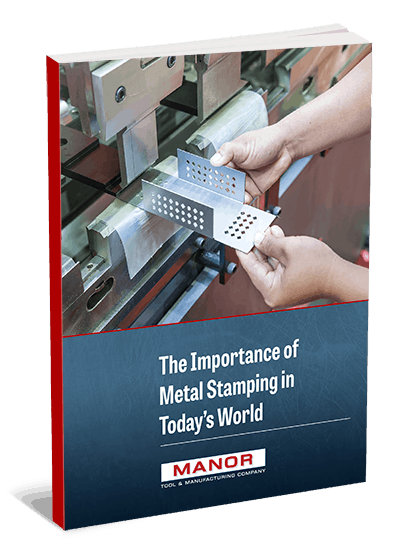Could Metal Stamping Create a Real Iron Man Suit?
Leave a CommentSince Iron Man first appeared in Marvel Comics in 1963, comic book fans and engineers alike have wondered at the feasibility of an exoskeleton that could enhance human strength and abilities. Iron Man’s popularity has soared since the character was introduced into the Marvel Cinematic Universe in 2008, and many fans have constructed their own Iron Man costumes with varying degrees of functionality. But what about the real thing?
The military has a long history of experimenting with fiction-inspired technologies, and the Iron Man suit didn’t escape their notice. The Pentagon’s Tactical Assault Light Operator Suit (TALOS) program was casually referred to in defense circles as the “Iron Man Suit” until the TALOS initiative shut down in 2019. The commercial sector has also pursued the development of powered mechanical suits, tracing back to General Electric’s failed Hardiman Suit program in the late 1960s.
As technologies like robotics, artificial intelligence, and wearable solutions continue to advance, efforts to build a real-life Iron Man suit will undoubtedly begin to show more promise. As they do, metal stamping will undoubtedly play a critical role in producing electronics and structural components used in Iron Man suits.
A Real-Life Iron Man Suit
A real-life Iron Man suit will require significant advances in the area of powered exoskeletons. A powered exoskeleton can be defined as a wearable machine that uses various electric motors, actuators, hydraulics, pneumatics, or other technologies to enhance the operator’s strength and endurance. Technologies have already emerged that establish a foundation for a future functional Iron Man suit:
- Rex Bionics created a powered exoskeleton to help patients with neurological disorders and spinal cord injuries with rehabilitation exercises.
- ReWalk robotics developed a wearable robotic exoskeleton that restores hip and knee mobility for people with spinal cord injuries.
- Ekso Bionics has released a series of industrial exoskeleton products to help reduce injuries and improve lifting and material handling capabilities in manufacturing, construction, and other industrial settings.
Spoiler alert if you haven’t seen 2016’s Captain America: Civil War, but it’s worth noting that these suits don’t look so different from a fictional powered exoskeleton built by Tony Stark for his best friend, Colonel James Rhodes. After Rhodes incurred an injury that paralyzed him from the waist down, Tony Stark designed an exoskeleton that allowed him to walk again.
Materials for an Iron Man Suit
In the Iron Man movie, the original suit is built from old missile parts, which would contain the iron alloys that gave the suit its name. The second iteration of the suit used a chromed titanium-steel alloy that couldn’t handle atmospheric flight and caused the suit to nearly crash. Stark’s Mark III suit employs a titanium-gold alloy for its armor components.
Building a working Iron Man suit here in the real world will require the use of strong and lightweight materials—some which may not even exist yet. It’s worth noting, however, that Marvel may not have been too far off base with titanium-gold alloy. Research at Rice University created a titanium-gold alloy for use in artificial joints that is four times harder than steel.
Essentially, a real-world Iron Man suit will require a mix of materials that offer strength, durability, performance, and low weight. Other viable material options for some suit components may include aluminum alloys, fiberglass, carbon fiber, or carbon nanotube.
How Metal Stamping Could Contribute to Manufacturing Iron Man Suits
Medieval suits of armor were crafted by skilled blacksmiths using forging and forming techniques that would evolve into modern metal fabrication methods. While ancient metal fabricators relied on manual forging, cutting, and bending to create armor pieces, modern powered exoskeleton armor could leverage advanced metal stamping to achieve many of the same goals.
Metal stamping encompasses a variety of processes used to turn flat sheet metal into intricate design shapes. A metal stamping press offers a variety of capabilities, including bending, blanking, coining, deep drawing, punching, piercing, and much more. Many demanding industries already rely on metal stamping to create an expansive range of high-performance parts and components, including:
Aerospace
Aerospace manufacturers prefer metal stamping for its ability to create reliable parts and components from difficult high-performance sheet metals like titanium, aluminum alloys, and galvanized steel.
Automotive
Automotive OEMs turn to metal stampers to create structural components, chassis elements, and mechanical parts used in vehicles.
Electronics
Metal stamping produces critical electronics components used in robotics, Internet of Things solutions, smart technology, wearable technology, and virtual/augmented reality solutions.
Military and Defense
Metal stamping has long provided essential components for military and defense equipment, including brackets, bushings, clips, connectors, housings, EMI shielding, and much more.Given the demonstrated capabilities of this technology, it stands to reason that metal stamping will have a critical role to play in the production of powered exoskeletons at some point in the near future.
Waiting for the Avengers to Assemble at Manor Tool
While metal stamping sees broad use across numerous industries, it seems that Stark Industries may not have an urgent need to incorporate the process into manufacturing its Iron Man suits. However, the metal stamping sector stands ready to answer the call and fabricate essential parts and components to be used within the suits when the time comes.
In the meantime, Manor Tool provides advanced metal stamping and deep drawing capabilities for numerous industries. For more information, please view our portfolio of services, or feel free to contact us or request a quote today.








